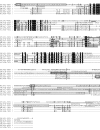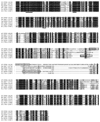The MB2 gene family of Plasmodium species has a unique combination of S1 and GTP-binding domains
- PMID: 15222903
- PMCID: PMC482805
- DOI: 10.1186/1471-2105-5-83
The MB2 gene family of Plasmodium species has a unique combination of S1 and GTP-binding domains
Abstract
Background: Identification and characterization of novel Plasmodium gene families is necessary for developing new anti-malarial therapeutics. The products of the Plasmodium falciparum gene, MB2, were shown previously to have a stage-specific pattern of subcellular localization and proteolytic processing.
Results: Genes homologous to MB2 were identified in five additional parasite species, P. knowlesi, P. gallinaceum, P. berghei, P. yoelii, and P. chabaudi. Sequence comparisons among the MB2 gene products reveal amino acid conservation of structural features, including putative S1 and GTP-binding domains, and putative signal peptides and nuclear localization signals.
Conclusions: The combination of domains is unique to this gene family and indicates that MB2 genes comprise a novel family and therefore may be a good target for drug development.
Figures






References
-
- Malaria at a glance; http://mosquito.who.int/cmc_upload/0/000/014/813/Malaria_at_a_glance1.htm. World Bank Report; 2001.
-
- Gardner MJ, Hall N, Fung E, White O, Berriman M, Hyman RW, Carlton JM, Pain A, Nelson KE, Bowman S, Paulsen IT, James K, Eisen JA, Rutherford K, Salzberg SL, Craig A, Kyes S, Chan MS, Nene V, Shallom SJ, Suh B, Peterson J, Angiuoli S, Pertea M, Allen J, Selengut J, Haft D, Mather MW, Vaidya AB, Martin DM, Fairlamb AH, Fraunholz MJ, Roos DS, Ralph SA, McFadden GI, Cummings LM, Subramanian GM, Mungall C, Venter JC, Carucci DJ, Hoffman SL, Newbold C, Davis RW, Fraser CM, Barrell B. Genome sequence of the human malaria parasite Plasmodium falciparum. Nature. 2002;419:498–511. doi: 10.1038/nature01097. - DOI - PMC - PubMed
Publication types
MeSH terms
Substances
Grants and funding
LinkOut - more resources
Full Text Sources
Other Literature Sources
Molecular Biology Databases

